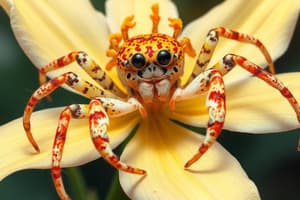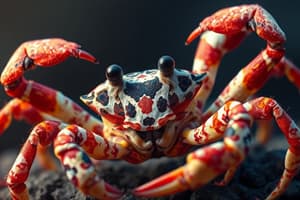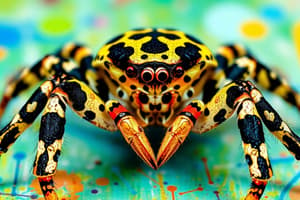Podcast
Questions and Answers
What primary advantage do female crab spiders gain from their camouflage behavior?
What primary advantage do female crab spiders gain from their camouflage behavior?
- Growing larger to deter predators
- Enhancing their mating displays
- Participating in cooperative mimicry
- Increasing their ability to hunt prey (correct)
What is the major finding of Wu and Gao's research regarding cooperation mimicry?
What is the major finding of Wu and Gao's research regarding cooperation mimicry?
- It facilitates color changes in male crab spiders
- It significantly reduces the lifespan of crab spiders
- It is the first evidence of cooperation mimicry in any species (correct)
- It requires individual performance without collaboration
How does cooperation mimicry potentially affect the survivorship of crab spiders?
How does cooperation mimicry potentially affect the survivorship of crab spiders?
- It reduces competition between individuals
- It leads to improved predation efficiency (correct)
- It eliminates the need for camouflage
- It increases their vulnerability to predators
Why is coloration in male crab spiders less prominent compared to females?
Why is coloration in male crab spiders less prominent compared to females?
What publication date reflects Wu and Gao's research findings?
What publication date reflects Wu and Gao's research findings?
What role did the male crab spider play in the camouflage strategy?
What role did the male crab spider play in the camouflage strategy?
How did the female crab spider enhance its camouflage compared to the male?
How did the female crab spider enhance its camouflage compared to the male?
What was the primary observation made by Shi-Mao Wu regarding the deception of the spiders?
What was the primary observation made by Shi-Mao Wu regarding the deception of the spiders?
Which description best fits the observation made during the study of the crab spiders?
Which description best fits the observation made during the study of the crab spiders?
What conclusion can be drawn about the teamwork of the male and female crab spiders?
What conclusion can be drawn about the teamwork of the male and female crab spiders?
Flashcards are hidden until you start studying
Study Notes
Crab Spider Camouflage
- Environmental scientists Shi-Mao Wu and Jiang-Yun Gao discovered a fascinating example of camouflage in a rainforest in China's Yuan Province.
- A male and female crab spider worked together to mimic a single flower.
- The male spider disguised itself as the flower's pistils and stamens, while the female disguised herself as the lighter petals.
Female Crab Spider Camouflage
- Female crab spiders commonly camouflage themselves to blend into their floral environment.
- They can change colors to match the flowers they are sitting on.
- They use this camouflage for predator protection and to catch unsuspecting prey.
Male Crab Spider Camouflage
- Male crab spiders are typically darker in color than the females.
- This study provides the first evidence of cooperation mimicry in any species.
Cooperative Mimicry
- The male and female spiders work together to create a convincing camouflage.
- This adaptation requires both participants to collaborate.
- The researchers believe this cooperative behavior expands the niche of both females and males in mimicry systems.
- This behavior could result in improved survivorship and predation efficiency.
Publication Information
- The researchers published their findings on March 1, 2024.
Studying That Suits You
Use AI to generate personalized quizzes and flashcards to suit your learning preferences.





